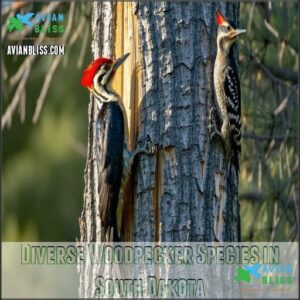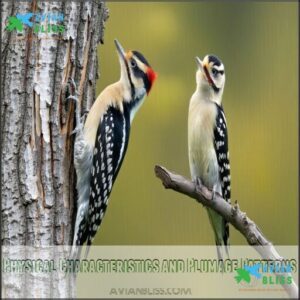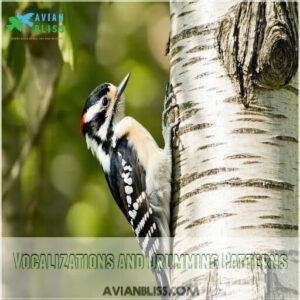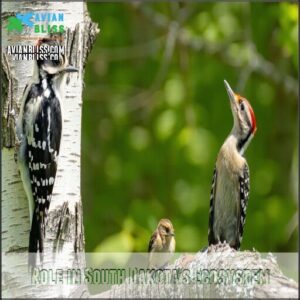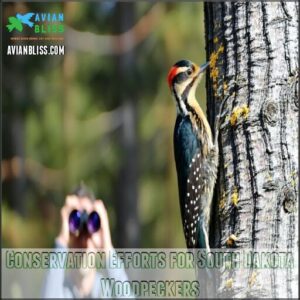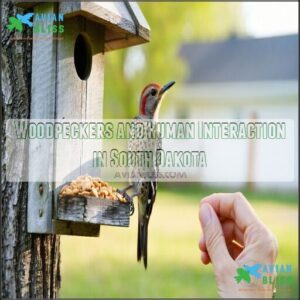This site is supported by our readers. We may earn a commission, at no cost to you, if you purchase through links.
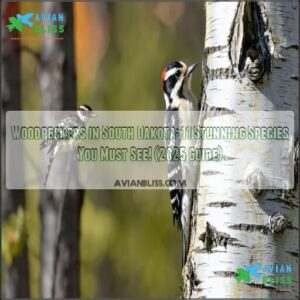 South Dakota is home to 11 fascinating woodpecker species, making it a hotspot for bird enthusiasts.
South Dakota is home to 11 fascinating woodpecker species, making it a hotspot for bird enthusiasts.
You’ll often spot the Downy Woodpecker—the smallest in the U.S.—bouncing along tree trunks in urban parks or forests.
For a rarer treat, head to the Black Hills and look for the Black-backed Woodpecker, known for thriving after forest fires.
These birds drum on trees not just for insect hunting but also to signal territory—it’s like nature’s version of texting, featuring birds like the Northern Flickers and Red-headed Woodpeckers.
Ready to explore?
Table Of Contents
- Key Takeaways
- Diverse Woodpecker Species in South Dakota
- Woodpecker Habitats Across South Dakota
- Identifying South Dakota’s Woodpeckers
- Woodpecker Ecology and Behavior in South Dakota
- Conservation Efforts for South Dakota Woodpeckers
- Woodpeckers and Human Interaction in South Dakota
- Frequently Asked Questions (FAQs)
- Are woodpeckers good to have in your yard?
- What bird looks like a woodpecker but isn’t?
- What does it mean when woodpeckers pecking at your house?
- Do northern flickers live in South Dakota?
- Is it good to have woodpeckers in your yard?
- What’s the difference between a woodpecker and a sapsucker?
- What does it mean when you see a woodpecker is pecking a tree?
- What is the difference between a sapsucker and a hairy woodpecker?
- What does it mean if a woodpecker is pecking my house?
- How do you tell the difference between a downy woodpecker and a Hairy Woodpecker?
- Conclusion
Key Takeaways
- You’ll find 11 woodpecker species in South Dakota, from the tiny Downy Woodpecker to the rare Black-backed Woodpecker in the Black Hills.
- Woodpeckers are nature’s maintenance crew, controlling pests, creating nest cavities for other wildlife, and promoting forest health.
- Habitat loss, climate change, and post-fire logging threaten woodpeckers like the Black-backed and American Three-toed species.
- Attract woodpeckers to your yard with suet feeders, native plants, and nesting boxes while reducing pesticides for healthy insect populations.
Diverse Woodpecker Species in South Dakota
You’ll discover eleven remarkable woodpecker species across South Dakota’s diverse landscapes, from the tiny Downy Woodpecker to the impressive Pileated Woodpecker.
The Black Hills National Forest serves as a special hotspot where you can spot rare species like the American Three-toed and Black-backed Woodpeckers that aren’t found elsewhere in the state.
Common Woodpecker Species
Five common woodpecker species call South Dakota home.
You’ll easily spot the small Downy Woodpecker and its larger lookalike, the Hairy Woodpecker, at backyard feeders.
Despite its name, the Red-bellied Woodpecker‘s most noticeable feature is actually its reddish cap.
Northern Flickers break woodpecker convention by frequently foraging on the ground for ants.
The striking Red-headed Woodpecker, with its crimson hood and black-and-white body, brings a splash of color to the state’s open woodlands and forest edges, showcasing a unique appearance among the species, including the Northern Flickers.
Rare and Uncommon Woodpecker Species
While common woodpeckers frequent many South Dakota backyards, their rarer cousins require special effort to spot.
These vagrant woodpeckers often inhabit remote areas of the state:
- Black-backed Woodpecker – Perfectly camouflaged against burnt trees in the Black Hills, these specialists thrive where others can’t
- Lewis’s Woodpecker – With its distinctive rosy face, this rare beauty primarily haunts western pinelands
- American Three-toed Woodpecker – Males sport yellow patches that flash among coniferous forests
- Red-naped Sapsucker – Elusive visitor with vibrant markings
The similar Red-headed Woodpecker is flamboyant, with a red head, white body, and black wings.
Migratory Patterns of South Dakota Woodpeckers
While rare species captivate attention, woodpecker migration in South Dakota offers its own seasonal drama.
You’ll find fascinating seasonal movements across the state, from the Black Hills to eastern woodlands.
| Species | Migration Style | Seasonal Presence |
|---|---|---|
| Yellow-bellied Sapsucker | Long-distance migrant | Spring/Fall passage only |
| Lewis’s Woodpecker | Erratic movements | Year-round with winter shifts |
| Red-bellied Woodpecker | Mostly resident | Some juvenile wandering |
Climate influence substantially affects these patterns, with some species like Red-headed Woodpeckers making short hops southward while others stay put.
Occasional vagrant sightings outside normal woodpecker range delight birders tracking South Dakota birds through changing seasons.
Subspecies and Hybridization in South Dakota
As woodpeckers travel through South Dakota, they’re not just crossing territories—they’re sometimes crossing genetic lines as well.
The Missouri River creates a natural boundary where Eastern and Western woodpecker populations meet, particularly noticeable in Northern Flickers.
You’ll find remarkable genetic diversity throughout the state:
- Flicker Subspecies include red-shafted (western) and yellow-shafted (eastern) variants, with hybrids showing mixed coloration
- Sapsucker Hybrids display blended physical traits that challenge identification
- Areas near the Missouri River serve as natural hybrid zones for multiple woodpecker species
- Interbreeding Impacts can include enhanced survival rates during harsh South Dakota winters
Identifying these mixed-ancestry birds adds an exciting challenge to your birdwatching adventures—watch for unexpected color patterns or behaviors that don’t quite match field guides.
Woodpecker Habitats Across South Dakota
You’ll find South Dakota’s woodpeckers thriving across diverse habitats, from the unique ecosystem of Black Hills National Forest to deciduous riverbanks and even your backyard bird feeder.
The state’s varied landscapes create perfect homes for these remarkable birds, with species like the Black-backed and American Three-toed woodpeckers exclusively inhabiting the pine forests of the Black Hills.
While adaptable Downy and Hairy woodpeckers can be spotted in both wilderness areas and suburban neighborhoods.
Black Hills National Forest Ecosystem
The Black Hills National Forest stands as South Dakota’s premier woodpecker sanctuary, where forest fire impact creates ideal conditions for these fascinating birds.
When exploring this biodiversity hotspot, you’ll discover specialized species thriving in its unique ecosystem.
- Black-backed woodpeckers flock to burned areas, preferring them 12.6 times more than beetle infestation sites
- Recently charred ponderosa pine trees attract woodpeckers seeking beetle larvae
- Conservation strategies include maintaining post-fire habitats for 1-8 years
- Water source dependence increases during summer months, driving woodpeckers to streams
Remember, these remarkable birds depend on the forest’s natural cycles, including beneficial wildfires. You can find Black Hills woodpecker gifts online.
Deciduous and Coniferous Forest Habitats
South Dakota’s forest composition creates ideal woodpecker habitats beyond just the Black Hills.
You’ll find distinct species preferences across various woodland environments:
Tree density and habitat fragmentation substantially impact which woodpecker species you’ll encounter, with forest management playing a vital role in maintaining these diverse ecosystems.
Consider exploring a woodpecker habitat guide for more insights into woodpecker species and their preferred environments.
Urban and Suburban Woodpecker Populations
Frequently, you’ll spot woodpeckers adapting to city life throughout South Dakota’s urban areas. These resourceful birds have developed remarkable adaptation strategies despite human impact.
Notable urban woodpecker behaviors include:
- Shifting diets to include backyard feeders and ornamental fruits
- Finding creative nesting locations in streetlights and building facades
- Adjusting drumming patterns to overcome noise pollution
- Using parks as critical resource availability islands
- Developing surprising tolerance to human activity
Common woodpeckers like Downies and Northern Flickers are especially adaptable. Consider attracting birds safely with the right setup. Try hanging a suet feeder—you’ll be amazed how quickly these resilient birds discover it!
Impact of Habitat Changes on Woodpecker Distribution
While urban areas offer surprising homes for some woodpeckers, habitat changes across South Dakota present significant challenges.
You’ll notice how forest fragmentation reduces nesting options for larger species, particularly in the Black Hills region.
Climate effects alter traditional territories, while fire suppression changes forest structure these birds depend on.
Urbanization impacts force woodpeckers to adapt or relocate, with invasive species often competing for limited resources.
Research shows South Dakota wildlife populations respond dramatically to these shifts, with woodpecker distribution patterns reflecting the health of our changing landscapes.
Identifying South Dakota’s Woodpeckers
You’ll quickly recognize South Dakota’s woodpeckers by their distinctive markings, from the tiny Downy’s spotted wings to the Northern Flicker’s bright tail feathers.
Learning to spot their unique physical traits, behaviors, and drumming patterns will transform your woodland walks into exciting treasure hunts for these remarkable birds.
Physical Characteristics and Plumage Patterns
Woodpeckers in South Dakota showcase remarkably distinctive plumage patterns, making field identification both challenging and rewarding.
Fieldwork amazes as South Dakota’s woodpeckers reveal dazzling feather patterns—nature’s vibrant artistry challenging birders to sharpen their identification skills.
When spotting these feathered architects in the wild, pay attention to their unique characteristics.
To identify South Dakota’s woodpeckers, focus on:
- Plumage coloration – From the Pileated Woodpecker’s dramatic red crest to the Hairy Woodpecker’s crisp black-and-white pattern
- Size variations – Compare the tiny Downy (sparrow-sized at 5.5 inches) to the crow-sized Pileated (16.5 inches)
- Sexual dimorphism – Males typically display more red feathering, like the Red-bellied Woodpecker’s full crimson cap versus the female’s limited neck patch
You’ll soon recognize these "knock-about neighbors" by their striking bill morphology and distinctive markings! Many birds display seasonal diet adaptations as well.
Behavioral Traits and Foraging Habits
Watching South Dakota’s woodpeckers forage reveals their specialized hunting techniques. Northern Flickers often hunt on the ground for ants, unlike their tree-dwelling cousins. You’ll notice Lewis’s Woodpeckers using a unique "flycatching" method, snatching insects mid-air instead of drilling bark.
When observing Sapsucker pecking, you’ll see methodical rows of holes created to collect flowing sap and trap insects. Pileated excavation involves powerful strikes that create distinctive rectangular holes while hunting carpenter ants.
Black-backed woodpeckers target burnt forests where they strip bark to find wood-boring beetle larvae – their favorite meal.
Downy Woodpeckers will happily visit your backyard suet feeders, while Red-bellied Woodpeckers cleverly cache nuts and seeds in tree crevices for winter. Each species has evolved specific woodpecker behavior that maximizes foraging success in their preferred habitat.
Vocalizations and Drumming Patterns
The forests of South Dakota hum with the rhythmic beats of woodpecker drumming and their species-specific calls. These sounds aren’t just random noise. They’re acoustic communication at its finest.
When identifying these birds, tune in for:
- The Downy Woodpecker’s light, rapid drumming—like morse code on a nature soundtrack.
- Northern Flickers’ lively “wicka-wicka” calls, a playful tune that stands out among the trees.
- Red-bellied Woodpeckers’ bold “churr-churr,” claiming territory with flair and persistence.
- Pileated Woodpeckers’ deep, echoing drumbeats that sound like a percussionist tuning up.
Drumming frequency varies by behavior. It’s a way to send territorial signals or stage flashy mating displays. Next time you hear woodpecker calls, imagine the forest’s band rehearsing—each bird practicing its part. In woodpecker behavior, there’s no such thing as silence.
Seasonal Variations in Appearance
Shifting from woodpecker vocalizations, let’s focus on how their looks change throughout the year—it’s like nature’s own fashion show.
These feathery updates, known as plumage molting, reveal surprising details:
- Spring: Males flaunt bright breeding colors to woo a mate.
- Summer: Feathers often appear worn—nesting and raising chicks takes its toll.
- Fall: Freshly molted feathers emerge richer and ready for winter survival.
- Winter: Subtler tones help with camouflage against predators.
- Juveniles: Lacking bold patterns, their plumage sets them apart from adults.
These seasonal changes, shaped by regional differences, turn woodpecker identification into a year-round treasure hunt!
Woodpecker Ecology and Behavior in South Dakota
You’ll discover that South Dakota’s woodpeckers aren’t just noisy—they’re nature’s skilled engineers and pest control experts.
From foraging for insects in burnt forests to creating nesting cavities that benefit other wildlife, their behavior plays a pivotal role in keeping ecosystems healthy.
Dietary Preferences and Foraging Techniques
Sharp beaks and sticky tongues turn South Dakota’s woodpeckers into specialized feeding machines. You’ll notice each species has unique foraging techniques perfectly adapted to their environment.
Northern Flickers break the mold with their ground foraging habit, feasting primarily on ants while their cousins search trees. Yellow-bellied Sapsuckers drill precise, orderly holes to extract sap and capture insects attracted to the sweet liquid.
The Red-bellied Woodpecker demonstrates impressive diet flexibility, switching between insect consumption in summer to stored acorns and nuts during winter months. Most species rely heavily on decaying wood, which serves as a buffet of beetles, larvae, and other insects year-round.
When insects become scarce in colder weather, many woodpeckers will happily visit your suet feeders to supplement their specialized diets.
Nesting Habits and Breeding Seasons
Exploring South Dakota woodpeckers during nesting season reveals nature’s most impressive architects.
When spring arrives, these remarkable birds begin their elaborate nest site selection process, transforming dead trees into perfect nurseries.
Here’s what you’ll observe in woodpecker nesting behavior:
- Males and females work together for 1-3 weeks to excavate their cavities, with each species having unique habitat preferences
- Clutch sizes vary from 3-8 glossy white eggs, carefully deposited on beds of wood chips
- Incubation periods typically span 11-14 days with parents taking turns warming eggs
- Fledgling care continues for 24-30 days after hatching, with parents teaching essential survival skills
- Breeding success depends heavily on cavity protection and predator avoidance techniques
During mating season, you’ll hear increased drumming as males establish territories. These nesting rituals, refined through evolutionary time, showcase the incredible parental dedication woodpeckers invest in their offspring.
Interspecies Competition and Cooperation
Competition shapes the daily interactions between South Dakota’s woodpecker species as they navigate shared territories and limited resources.
When you visit the Black Hills, you’ll witness fascinating competitive dynamics among these remarkable birds:
- Resource partitioning allows multiple species to coexist, with Downy Woodpeckers foraging on twigs while Pileated Woodpeckers tackle larger trunk areas
- Nest cavity battles occur frequently, as Western Bluebirds sometimes usurp Black-backed and Hairy Woodpecker nests through coordinated tag-team efforts
- Foraging preferences reduce direct competition, with most woodpeckers showing a particular fondness for oak trees regardless of their availability
- Territory overlap management happens through interspecific signals, including distinctive drumming patterns that communicate boundaries
You’ll notice how Red-headed Woodpeckers occasionally take over existing nest cavities in western South Dakota’s forests. This "woodpecker real estate market" creates a complex web of interactions where species must balance competition with cooperative behaviors to survive in their habitat.
Role in South Dakota’s Ecosystem
If you’ve ever walked through South Dakota’s diverse landscapes, you’ve witnessed woodpeckers serving as nature’s maintenance crew for the ecosystem.
These remarkable birds perform essential environmental services that extend far beyond their charming appearances.
You’ll find these ecosystem engineers throughout South Dakota, from the Black Hills to river bottoms, where their drumming indicates active habitat creation.
Their constant foraging maintains forest health while promoting biodiversity conservation.
Without woodpeckers, South Dakota’s woodlands would face unchecked insect populations and reduced homes for cavity-nesting wildlife.
Conservation Efforts for South Dakota Woodpeckers
You’ll find various conservation programs working to protect South Dakota’s woodpecker species, especially in the Black Hills National Forest.
Your participation in citizen science projects can help researchers track population trends and develop targeted protection strategies for these remarkable birds, particularly rare species like the American Three-toed and Black-backed Woodpeckers that face habitat challenges.
Threatened and Endangered Woodpecker Species
When you explore South Dakota’s woodlands, you’ll find certain woodpecker species facing serious conservation challenges. The Black-backed Woodpecker is currently being considered for federal protection, with a population of only about 3,000 birds in the Black Hills region.
Habitat loss, particularly through post-fire logging of burned forests, represents the greatest threat to their survival. The American Three-toed Woodpecker and Lewis’s Woodpecker are also experiencing population decline due to habitat changes.
Climate impacts further strain these specialized birds, who serve as key indicators of ecosystem health. Conservation efforts focus on preserving their remaining natural habitats to address these conservation efforts.
Habitat Preservation Initiatives
Working tirelessly across South Dakota, conservation groups have launched vital habitat preservation initiatives to protect our woodpecker populations.
The Black Hills National Forest implements targeted Forest Management strategies that maintain standing dead trees—vital woodpecker habitat—while still addressing forest health concerns.
Private landowners now play a key role in woodpecker conservation through incentive programs that reward habitat protection:
- The "Snags for Birds" program offers tax benefits to those who preserve dead trees on their property
- Conservation easements protect wooded areas from Urban Development pressure
- Reforestation Efforts focus on diverse tree species that support various woodpecker feeding habits
You’ll notice these initiatives especially in areas recovering from Burned Forest conditions, where species like the Black-backed Woodpecker thrive. By participating in local conservation programs, you’re helping guarantee these remarkable birds continue drumming through South Dakota’s forests for generations.
Impact of Climate Change on Woodpecker Populations
While habitat preservation creates immediate safety for woodpeckers, climate change presents a longer-term threat to South Dakota’s wooden-hammering residents.
As South Dakota has warmed 1-2°F over the past century, you’ll notice several concerning trends when observing these remarkable birds:
- Habitat loss intensifies as drought-weakened trees become less viable for nesting and foraging, particularly affecting specialists like the Black-backed Woodpecker.
- Insect availability fluctuates unpredictably, forcing woodpeckers to expand their hunting territories or switch food sources.
- Migration shifts occur as species adjust their ranges northward, creating new competitive dynamics in previously stable ecosystems.
These changes particularly impact breeding success, with earlier springs disrupting traditional nesting cycles. When woodpeckers can’t synchronize with peak insect emergence, fewer chicks survive.
The warming climate also increases forest fire frequency in the Black Hills, which paradoxically creates temporary habitat for some species while destroying it for others—a complicated conservation puzzle that requires ongoing monitoring. This can lead to phenological sensitivity issues impacting breeding.
Citizen Science Programs for Woodpecker Monitoring
As our climate impacts woodpeckers across South Dakota, you can help track these changes through citizen science programs. These initiatives turn your birdwatching hobby into valuable research data!
Most programs offer volunteer training that’s straightforward and fun. You’ll learn proper reporting methods for woodpecker sightings in South Dakota, addressing common accuracy concerns through standardized techniques.
"One person’s backyard observation can fill vital data gaps," explains a program coordinator from Rapid City.
Program expansion has reached even remote areas of the state, with participation doubling since 2023. Whether you’re spotting Downy Woodpeckers at your feeder or tracking rare Black-backed specimens in the Hills, your observations matter. As birdwatchers like to say, "Every peck counts" and contributes to understanding population trends and habitat mapping, making your involvement in citizen science truly valuable.
Woodpeckers and Human Interaction in South Dakota
You’ll find South Dakota’s woodpeckers frequently crossing paths with humans, whether they’re visiting your backyard feeders or occasionally drumming on your home’s siding.
From attracting these fascinating birds to your yard with the right food offerings to managing potential property damage, your interactions with South Dakota’s woodpeckers can be both rewarding and educational.
Attracting Woodpeckers to Backyard Habitats
Transform your South Dakota backyard into a woodpecker paradise with a few strategic additions. You’ll be amazed how quickly these charismatic drummers become regular visitors!
Start with food sources that woodpeckers can’t resist. Mount suet feeders on tree trunks or poles at least five feet high where these birds feel secure. For variety, try peanut feeders or specialized woodpecker seed mixes. South Dakota also boasts a wide variety of common backyard birds beyond woodpeckers.
- Native plantings like oaks, dogwoods, and serviceberries provide natural foraging opportunities
- Proper nesting box placement (10-20 feet high in partially shaded areas) attracts species like Downy and Hairy Woodpeckers
- Shallow water sources with textured edges help woodpeckers grip while drinking
- Leaving deadwood sections in trees (when safe) creates natural feeding spots
Remember to limit pesticides in your yard to guarantee a healthy insect population. With these simple changes, your backyard bird feeders will soon attract South Dakota’s most stunning drummers, turning ordinary birdwatching into a daily delight.
Managing Woodpecker Damage to Structures
Those sharp rat-a-tat sounds on your home’s siding might signal unwelcome woodpecker guests. While these feathered drummers are protected by federal law in South Dakota, you can still manage woodpecker damage effectively.
Start with prevention strategies like installing mesh netting with 3-inch clearance from surfaces. Visual deterrent methods work well—try hanging reflective objects or placing predator decoys near problem areas.
For existing damage, repair techniques include sealing holes with metal plates and applying protective sealants. Consider woodpecker relocation by installing nest boxes away from structures.
Remember that harder exterior construction materials naturally discourage drilling. For severe cases, woodpecker control permits may be available through US Fish and Wildlife Service.
Birdwatching Opportunities and Popular Locations
South Dakota’s sprawling wilderness offers prime viewing spots for woodpecker enthusiasts year-round. You’ll find these feathered drummers most active during morning hours when their distinctive tapping echoes through the forests.
- Black Hills National Forest hosts rare species like Black-backed and American Three-toed Woodpeckers
- Custer State Park’s French Creek trail delivers reliable Red-headed Woodpecker sightings
- Missouri River corridors attract Red-bellied Woodpeckers during seasonal migrations
- Newton Hills State Park becomes a woodpecker haven during spring migration
- Urban parks in Sioux Falls offer surprising Downy and Hairy Woodpecker viewing opportunities
Bring binoculars and practice patience—these shy birds reward quiet observers!
Cultural Significance of Woodpeckers in South Dakota
While exploring the natural beauty of South Dakota’s woodpecker hotspots, you’ll discover these birds have deeper cultural roots than their distinctive drumming suggests.
Woodpeckers in South Dakota have profound significance in Native American lore, where they’re viewed as spiritual messengers between worlds. Local art celebrates these remarkable birds through everything from traditional carvings to contemporary wildlife paintings.
| Cultural Element | Woodpecker Symbolism | Example in South Dakota |
|---|---|---|
| Lakota Tradition | Persistence & strength | Black Hills ceremonies |
| Local Folklore | Weather prediction | "Woodpecker rain" sayings |
| Place Names | Recognition of habitat | Woodpecker Ridge trails |
Next time you hear that familiar tapping while bird watching in South Dakota, remember you’re experiencing more than wildlife—you’re connecting with centuries of native cultural heritage and understanding the importance of spiritual messengers and traditional carvings.
Frequently Asked Questions (FAQs)
Are woodpeckers good to have in your yard?
Yes, woodpeckers are great for your yard!
They control pests, help trees by removing dead wood, and create nesting holes that other wildlife use.
Just watch out—they might fancy your wooden siding too!
What bird looks like a woodpecker but isn’t?
Many birds mimic woodpeckers, but the Northern Flicker often fools you.
It’s a ground-loving bird with spotted feathers and bright tails.
Think of it as the woodpecker’s quirky cousin, trading trees for ants!
What does it mean when woodpeckers pecking at your house?
When woodpeckers peck at your house, they’re likely searching for insects, marking territory, or creating nesting holes.
They might even mistake your siding for a tree.
Fix holes quickly to deter further activity.
Do northern flickers live in South Dakota?
Northern flickers definitely call South Dakota home.
You’ll find both red-shafted and yellow-shafted subspecies here.
They’re quirky birds, often seen hunting ants on the ground, so keep your eyes peeled near open woods or fields!
Is it good to have woodpeckers in your yard?
Inviting woodpeckers to your yard is like hosting a cleanup crew—they control pesky insects and even help trees by removing dead wood.
Just remember, their drumming might test your patience, especially on quiet mornings!
What’s the difference between a woodpecker and a sapsucker?
A woodpecker pecks wood for food and shelter, while a sapsucker targets trees for sap using neat rows of holes.
Think of sapsuckers as bark baristas, while woodpeckers are the forest’s carpenters.
What does it mean when you see a woodpecker is pecking a tree?
Seeing a woodpecker pecking a tree means it’s either searching for insects, digging a nest, or drumming to mark territory.
It’s like nature’s DIY expert—paving the way to meet its needs!
What is the difference between a sapsucker and a hairy woodpecker?
A sapsucker drills rows of shallow holes to feed on tree sap, while a hairy woodpecker focuses on insects and uses its longer bill to chisel deeper into wood.
Both share distinct feeding habits.
What does it mean if a woodpecker is pecking my house?
It’s like your house is a buffet for bugs or a drumset for territorial claims.
Woodpeckers peck homes searching for insects, nesting spots, or to attract mates—all part of their natural behavior.
How do you tell the difference between a downy woodpecker and a Hairy Woodpecker?
Size and beak length are key! Hairy woodpeckers are larger, with a long, chisel-like beak almost as big as their head.
Downy woodpeckers are smaller, and their stubby beak looks shorter than their head.
Conclusion
Exploring woodpeckers in South Dakota is like opening a treasure chest of biodiversity—each species brings unique behaviors and beauty.
Whether it’s the petite Downy Woodpecker or the elusive Black-backed Woodpecker, these birds play essential roles in the ecosystem.
Take time to visit forests, parks, and even your backyard to spot their drumming or vibrant plumage.
By preserving habitats and participating in citizen science, you can help guarantee these fascinating species thrive for generations to come.

